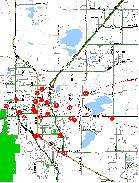
Leaking Underground Storage Tanks
Contaminants
Federal
UST Legislation
State Support
Cleanup Status
UST Definitions
Colorado
Oil Inspect Sec
UST Data
LUST
Anatomy
Corrosion
Leaks
Site Character
Remediation
Source
Groundwater
New Tanks
Installation
Monitoring
City of Boulder
A Search for LUSTs in Boulder
As of October 2000, the Oil Inspection Section lists 24 "active" leaking underground storage tanks (LUSTs) in the City of Boulder containing petroleum products (spreadsheet) on its UST and LUST search page. "Active" sites are classified as those for which a confirmed release has been reported and a closure (no further action) letter has not been issued by the Oil Inspection Section. Details of the response to the LUST are reported on the Oil Inspection Section's data base.
The locations of these sites can be viewed on a map of Boulder. Most of these sites (16) are gasoline stations (Amoco, Conoco, Diamond Shamrock, Mobil, Texaco, and Total). Two active LUSTs are located at Bartkus Oil Company on Pearl Street. The Boulder Bump Shop on 49th Street, Memorial Hospital on Mapleton Avenue, the RTD facility on Exposition Drive, and the Western Mobile (now LaFarge) asphalt plant on Valmont Avenue each have an active LUST.
The Oil Inspection Section also provides data on "closed," or inactive, LUSTs in the City of Boulder -- there are 157 closed LUSTs in Boulder. "Closed" sites are defined as those for which a closure letter has been issued. Issuance of a closure letter indicates that groundwater contamination problems have been completely addressed. Only 37 of the closed sites are gasoline stations. The others include a wide variety of industrial, commercial, and government locations.
LUST Groundwater Contamination in Boulder
Are LUSTs a threat to drinking water quality in Boulder? In general, the answer is NO. Residents of the City of Boulder have their drinking water supplied through a system of water mains and pipes from two water treatment plants at Betasso and the Boulder Reservoir. These plants treat water collected from surface sources -- Barker Reservoir, Lakewood Reservoir, Silver Lake, Boulder Reservoir, and the Boulder Feeder Canal. No groundwater is used as drinking water in Boulder; therefore, contamination of groundwater in Boulder is not a threat to drinking water quality.
Gasoline contamination in groundwater presents other hazards. Because gasoline is lighter than water, gasoline floats on the water table and remains relatively close to the land surface. The most hazardous compounds in groundwater, the BTEX compounds, are quite volatile. These volatile compounds can enter nearby buildings. In poorly ventilated buildings, the compounds can accumulate and present a health risk through inhalation. In buildings, the volatile compounds can also present an explosion hazard.
Other LUST Issues in Boulder
New development often uncovers old problems. One of these problems is underground storage tanks. At the sites of many former gasoline stations, USTs were left in the ground and contamination problems were never adequately addressed. When new construction encounters USTs and LUST contamination, a remedial response must be made.
The construction of a new shopping center near the intersection of Pearl Street and 28th Avenue required re-aligning 26th Street on the north and south side of Pearl Street. Before the re-alignment could occur, the City and the developer had to resolve a LUST problem associated with the property on the southwest corner of 26th and Pearl, formerly an Amoco gasoline service station. Although the station ceased operation in the mid-1980s, the underground storage tanks were removed only a few years ago. According to the developer, the tanks were not completely empty at the time Amoco ceased operations, but were instead left with quantities of gasoline in them. An environmental analysis prepared by Walsh Environmental, dated January 1997, indicates that petroleum hydrocarbon contamination of groundwater occurred and saturated soils in a plume extending to the east of the former Amoco station, including the areas under both the existing and proposed 26th Street rights-of-way. The developer and the City Attorney's Office worked together to obtain a commitment from Amoco to accept financial responsibility for cleaning up the contamination. An agreement was reached which should allowed the developer, in partnership with Amoco, to clean up the contamination during construction of the re-aligned street.
This map shows the location of the 24 active LUST sites in Boulder.
